Citric Acid
Last update 2022-05-27
Citric acid production process

(1) Crushing
The cleaned corn after removing the impurities and metering is sent to the hammer mill to crush. Then, it is sent to the rotary vibration screen. After that, it is sent to the tank for the storage. The corn flour size: 60 mesh screen underflow is ≤30%。
(2) Adjusting
Adding water to adjust the flour slurry with DS=28-32%. The metered flour slurry is sent to the PH adjusting tank by the NaON solution and with enzyme adding.
(3) Liquefaction
The qualified corn four slurry is sent to 1st jet cooker then liquefaction column for starch gelatinization and liquefaction.
(4) Saccharification: The liquefied liquor is sent to second jet cooker for enzyme killing and protein agglomeration after liquefaction, then it will be sent to sacchrification tanks to get required DE after cooling and enzyme adding.
(5) Filtration
After liquefaction, take filter press to filtrate the coarse protein from saccharified liquid. Then the filtrate is sent to next section and coarse protein is sent to dryer for drying.
(6) Seed production
After saccharification, some part of saccharified liquid is sent to the seed tank to adjust the DS value and PH, sterilization and cooling, then for the bacterial growing. The strains fermentation is with high temp resistant and high production yield.
(7) Fermentation
After filtration, the filtrateis sent to the fermentation tank to adjust the DS value and PH, sterilization and cooling to 35℃. Adding the strain to the fermentation tank by the sterilized piping for the fermentation with sterile air feeding continuously. When the residue glucose is lower than 1g/L, then the fermentation is finished.
(8) Pre-filtration
Besides the citric acid product, there are some impurities, such as mycelium. Filtering the impurities out is the 1st step to make sure the citric acid quality. The mycelium after washing is sell to the feed production. And the filtrate is thin citric acid for the 1st neutralization.
(9) 2nd filtration
After pre-filtration, there are still some fine impurities. The 2nd filtration is used for removing the fine impurities again to make sure the filtrate clear and transparent. After washing the filter cake, the filtrate is thin citric acid for the 2nd neutralization.
(10) 1st neutralization
Adding CaCO3 to the thin citric acid, get Ca3(C6H5O7)2•4H2O as the sediment. It is filtered by the vacuum filter. The filtrate is as the waste water to the ETP.
(11) 2nd neutralization
The sediment of Ca3(C6H5O7)2•4H2O is adjusted, then reaction with the filtrate after 2nd filtration to get CaH(C6H5O7) •3H2O as the sediment, which is filtered by the vacuum filter. The filtrate is used for the 1st neutralization. The CaH(C6H5O7) •3H2O after adjusting is sent to the next section.
(12) Acidehydrate
The CaH(C6H5O7) •3H2O after adjusting is made reaction with H2SO4 to get citric acid (C6H8O7) and CaSO4. The CaSO4 is filtered out by the belt vacuum filter to get the CaSO4 crystalline for selling to the gypsum production. And the citric acid is sent to the next section.
(13) Decoloring and filtration
Adding active carbon to the citric acid with agitating for the decoloring. Then to the next refinery section.
(14) Ion exchange
The filtration of above section is sent to ion exchangers for removing cation and anion as well as bad odor and soluble impurities to get refined citric acid.
(15) Monohydrate citric acid evaporation
After filtering by the check filter, the citric acid is sent to the evaporator to get high DS value of product.
(16) Monohydrate citric acid crystallization
The qualified CAM after evaporation is sent to the crystallization section for the crystallization. After keeping crystal at proper time, the crystal will be got, and then it is sent to the refinery section.
(17) Anhydrous citric acid crystallization
The CAA after evaporation is sent to the forced circulation evaporating crystallizer to get the crystal.
(18) Separation
After crystallization, both crystallized CAM and CAA are sent to the separator to separate the mother liquid, then get the qualified wet products to next section.
(19) Drying & sieving
The wet product is sent to dryer to get the dried product, then sent to the vibration sieve to get the qualified product.
Plant 3D Drawing
